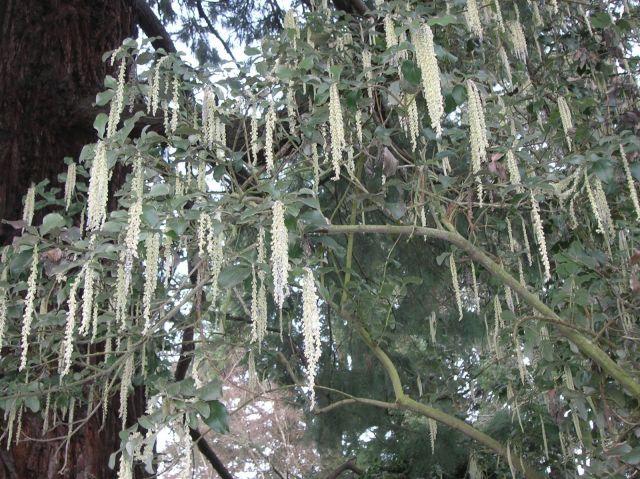A Winner in the Winter Garden: Coast Silktassel

Coastal silktassel in late January at Bishop's Close garden, Portland
Image: Kate Bryant
Everyone has at least one difficult spot in their garden: a dry, shady area where, no matter what you plant, only weeds seem to grow.
Silktassel could be your solution to that problem.
In addition to being a great problem-solver plant for dry shade, silktassel happens to be one of the most subtly beautiful and elegant winter-interest plants that can be grown in the Pacific Northwest. And that's serious praise, where we have so many lovely winter-blooming shrubs.
Coast silktassel (Garrya elliptica) grows to around 12-15 feet tall and wide, with dark green, wavy-margined leaves and whitish undersides. Flowers, appearing in late December and lasting through March, consist of long, pendant, silvery-green catkins reaching as much as 8 inches long on some cultivars such as James Roof and Pat Ballard. Plants are dioecious, meaning that plants are either male or female. Male plants, such the two types listed above, typically produce longer catkins, while most females are less showy but produce fruit when pollinated by a male. If you have extra room, it would be worth planting a female near the male plant, as birds love to eat the small fruit.
On a mature plant, these graceful catkins, set against the dark green, wavy, evergreen foliage, are a dramatic sight in winter. En masse, the flowers look like sheets of tinsel.
While considered an Oregon native, Coast silktassel isn’t technically native as far north as the Portland area. However, its sister plant, mountain silktassel (Garrya fremontii), can be found as close as Wind River area in SW Washington and south to California. Both plants thrive in the Portland area but mountain silktassel is a bit smaller, with slightly shorter catkins and better cold, heat and drought-tolerance, so can sometimes work in a tighter or more challenging spot. Try silk tassels in the dry areas around conifers, along with other natives like Oregon grape, flowering currant and sword ferns. Just make sure you water them well during their first few years in the ground, to get them properly established.
Silktassels can be found at Forest Farm, Gossler Farm Nursery, and most local nurseries. Buy them now and plant them as soon as possible - they don't do so well in pots over the summer so they can be hard to find outside the winter season. Find more silktassel vendors at Plant Lust.
